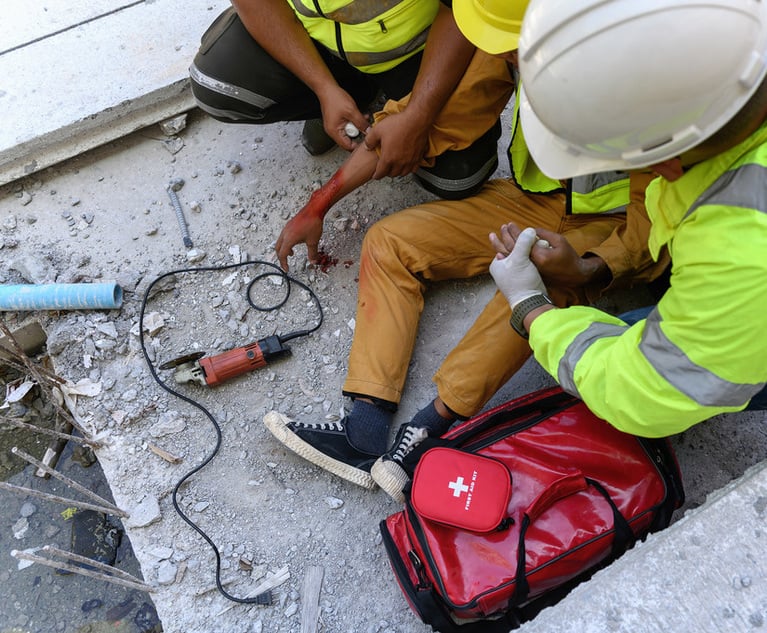Community Association Transition: Construction Defects, Implied Warranties and Consumer Fraud
A successful transition from a developer to a homeowner-controlled board is one in which the two parties work together to ensure appropriate governance, adequate financial resources, and a properly designed and constructed community. But what happens when negotiations fail?
May 16, 2019 at 11:30 AM
8 minute read
 Credit: ThomasPhoto/Shutterstock.com
Credit: ThomasPhoto/Shutterstock.com
For every condominium and homeowner association, “control” is eventually transferred by the developer to an owner-controlled governing board after construction. This is called “transition.” A successful transition is one in which the owner-controlled board works with the developer to ensure appropriate governance, adequate financial resources, and a properly designed and constructed community. But what happens when negotiations fail?
How Does It Work?
The procedure for effective turnover of control is set forth by the New Jersey Condominium Act, N.J.S.A. 46:8B-1et seq., and the New Jersey Planned Real Estate Development Full Disclosure Act (PREDFDA), N.J.S.A. 45:22A-21, et seq. Under the Condominium Act, unit owners are statutorily entitled to elect all of the members of the governing board upon the conveyance of 75% of the units in a condominium. PREDFDA provides that turnover may occur on one of three triggers:
- 60 days after conveyance of 25% of the lots, parcels, units or interests, not less than 25% of the members of the executive board shall be elected by owners;
- 60 days after conveyance of 50% of the lots, parcels, units or interests, not less than 40% of the members of the executive board shall be elected by the owners; or
- 60 days after conveyance of 75% of the lots, parcels, units or interests, the developer's control of the executive board shall terminate at which time the owners shall elect the entire executive board.
N.J.A.C. 5:26-8.4(a). However, notwithstanding these events, the developer may retain one seat on the executive board so long as there are any units remaining unsold. N.J.A.C. 5:26-8.4(b). And, a developer may surrender control at an earlier time, provided the owners agree by majority vote to assume control. N.J.A.C. 5:26-8.4(c)-(d) (emphasis added).
The legislative intent of these statutes is to protect unit owners. As the court stated in in Flinn v. Amboy Nat. Bank, 436 N.J. Super. 274 (App. Div. 2014), transition ensures that control passes to unit owners to ensure that they are in a position to safeguard their property interests. Moreover, “[t]he developer is not to retain control of the association once it becomes clear that the statutory criteria for the transfer of that control have been triggered” (emphasis added).
The timing of turnover is critical. Until transition occurs, the developer has a fiduciary responsibility to the unit owners in the administration and management of the association. However, once transition occurs, the owner-controlled association assumes responsibility for the administration and management of the association through its executive board. And, of course, the interests of the developer and those of the association are no longer aligned and often diverge.
What Happens Next?
There are many moving parts involved in transition. If there are no obvious and significant construction defects, and a negotiated settlement is best for all parties, “transition” consists of completing punch-list items, resolving any reserve discrepancies, and releasing any municipal bonds. The owner-controlled governing board should seek evaluations by professional architects, engineers and accountants to ensure that (a) all common areas have been designed and constructed properly, and (b) the developer has properly identified, accounted for and appropriately allocated reserves for the future replacement of common elements. These tasks should all be completed before negotiating any transition settlement or entering into a release in favor of the developer. Sometimes litigation is inevitable. This is true whether it arises from costly repairs, unrealistic demands by the association, refusal of a developer to accept responsibility, or a legitimate disagreement. In these instances, litigation is appropriate. While there are many avenues for recovery against the design professionals and contractors, the implied warranty of habitability and Consumer Fraud Act provide potential avenues of recovery against developers.
In New Jersey, it is well established that implied warranties apply to both commercial and residential construction projects. See, e.g., Hodgson v. Chin, 168 N.J. Super. 549 (App. Div. 1979); McDonald v. Mianecki, 79 N.J. 275 (1979); Aronsohn v. Mandara, 98 N.J. 92 (1984). With respect to residential construction in particular, New Jersey courts have found that implied warranties of habitability and workmanship apply. Builders must construct a residential dwelling that it is appropriate for its intended use, of reasonable workmanship and habitable.
The extension of implied warranties of workmanship and habitability to residential construction projects bucks the traditional doctrine of caveat emptor, or “buyer beware.” Indeed, in Schipper v. Levitt & Sons, 44 N.J. 70 (1965), the court observed that “[b]uyers of mass-produced development homes are not on an equal footing with the builder vendors and are no more able to protect themselves in the deed than are automobile purchasers in a position to protect themselves in a bill of sale.” Id. at 91–92. A few years later, in McDonald, supra., the Supreme Court extended the principles of Schipper to a small-scale builder of new homes and held that the implied warranty of habitability applied such that the doctrine of caveat emptor “as applied to new houses is an anachronism patently out of harmony with modern home buying practices.” Id. at 290. The imposition of an implied warranty of habitability and workmanship on builders reflects an equitable risk allocation to the developer of the necessary expertise to discover and address nonconformity resulting from defective design, materials or installation.
Many of these defects are latent—not readily observable to the untrained eye. Internal components of a home such as septic systems, pipes, ventilation, framing components, roofs and foundations are not subject to a simple visual inspection regarding potential defects. Further, many defects remain dormant for years before their symptoms manifest. Ultimately, the builder is the only party that can be reasonably expected to prevent defective construction and, in particular, detect issues with systems that will remain hidden behind other components of the building. Thus, it is reasonable for unit owners to rely upon the skill and experience of developer entities to construct the condominium with reasonable workmanship and be fit for habitation.
In addition, a developer's responsibility is heightened by the New Jersey Consumer Fraud Act (CFA) which prohibits deception in the marketing and sale of real estate. In this context, consumer fraud means misrepresentations or omissions in the Public Offering Statement (POS) filed with the Department of Community Affairs and provided to prospective purchasers.
An affirmative misrepresentation in the POS or other marketing material is actionable under the CFA if it is material to the transaction, false in fact, and made to induce the buyer to purchase—regardless of whether the buyer has in fact been misled. A fact is material if “a reasonable person would attach importance to its existence in determining a choice of action[,]” or if one knows that another “regards or is likely to regard the matter as important in determining [a] choice of action, although a reasonable [person] would not so regard it.” Ji v. Palmer, 333 N.J. Super. 451, 462 (App. Div. 2000) (citation omitted).
A developer who makes an affirmative misrepresentation is liable even in the absence of knowledge of the falsity of the misrepresentation, negligence or the intent to deceive. For example, in Belmont Condo. Ass'n v. Geibel, 432 N.J. Super. 52, 62 (App. Div. 2013), cert. den., 216 N.J. 366 (2013), the Appellate Division upheld a claim under the CFA against a developer of a condominium, based on a statement made in its public offering statement that there were no known defects in the common elements of the building that a prospective purchaser could not determine by a reasonable inspection. The jury in Belmont found that the developer's affirmative statement—while true when made before construction—had the capacity to mislead an average reader because the building suffered from water infiltration and mold infestation as a result of various construction deficiencies resulting in the imposition of treble damages and the shifting of counsel fees and costs. Id. at 68, 80.
To recap, the first thing to do when faced with transition is to identify the triggering event for a change in control. Once control is turned over, the association should seek out the appropriate professionals and legal counsel during transition to guide them through the process to ensure that all risks are appropriately addressed. While negotiation is the preferred end to transition, litigation may be necessary. The correction of non-conforming defects is usually an expensive endeavor and will undoubtedly burden an owner or association with unexpected costs. Variations from building codes may also subject the developer to liability. Thus, engagement of experienced counsel conversant with the implied warranty of habitability and the CFA is critical to proceeding forward once negotiations break down.
Matthew Meyers is a shareholder at Becker & Poliakoff's Morristown office in the Construction Law and Litigation Practice.
This content has been archived. It is available through our partners, LexisNexis® and Bloomberg Law.
To view this content, please continue to their sites.
Not a Lexis Subscriber?
Subscribe Now
Not a Bloomberg Law Subscriber?
Subscribe Now
NOT FOR REPRINT
© 2025 ALM Global, LLC, All Rights Reserved. Request academic re-use from www.copyright.com. All other uses, submit a request to [email protected]. For more information visit Asset & Logo Licensing.
You Might Like
View All

Dispute Resolution Boards—Getting Real Time Decisions on Construction Projects
7 minute read
Insurer Has No Duty to Defend 'Laidlow' Claims, NJ Supreme Court Says
3 minute read
Construction Worker Hit by Falling Concrete Settles Claims for $2.3M
4 minute readTrending Stories
- 1'A Death Sentence for TikTok'?: Litigators and Experts Weigh Impact of Potential Ban on Creators and Data Privacy
- 2Bribery Case Against Former Lt. Gov. Brian Benjamin Is Dropped
- 3‘Extremely Disturbing’: AI Firms Face Class Action by ‘Taskers’ Exposed to Traumatic Content
- 4State Appeals Court Revives BraunHagey Lawsuit Alleging $4.2M Unlawful Wire to China
- 5Invoking Trump, AG Bonta Reminds Lawyers of Duties to Noncitizens in Plea Dealing
Who Got The Work
J. Brugh Lower of Gibbons has entered an appearance for industrial equipment supplier Devco Corporation in a pending trademark infringement lawsuit. The suit, accusing the defendant of selling knock-off Graco products, was filed Dec. 18 in New Jersey District Court by Rivkin Radler on behalf of Graco Inc. and Graco Minnesota. The case, assigned to U.S. District Judge Zahid N. Quraishi, is 3:24-cv-11294, Graco Inc. et al v. Devco Corporation.
Who Got The Work
Rebecca Maller-Stein and Kent A. Yalowitz of Arnold & Porter Kaye Scholer have entered their appearances for Hanaco Venture Capital and its executives, Lior Prosor and David Frankel, in a pending securities lawsuit. The action, filed on Dec. 24 in New York Southern District Court by Zell, Aron & Co. on behalf of Goldeneye Advisors, accuses the defendants of negligently and fraudulently managing the plaintiff's $1 million investment. The case, assigned to U.S. District Judge Vernon S. Broderick, is 1:24-cv-09918, Goldeneye Advisors, LLC v. Hanaco Venture Capital, Ltd. et al.
Who Got The Work
Attorneys from A&O Shearman has stepped in as defense counsel for Toronto-Dominion Bank and other defendants in a pending securities class action. The suit, filed Dec. 11 in New York Southern District Court by Bleichmar Fonti & Auld, accuses the defendants of concealing the bank's 'pervasive' deficiencies in regards to its compliance with the Bank Secrecy Act and the quality of its anti-money laundering controls. The case, assigned to U.S. District Judge Arun Subramanian, is 1:24-cv-09445, Gonzalez v. The Toronto-Dominion Bank et al.
Who Got The Work
Crown Castle International, a Pennsylvania company providing shared communications infrastructure, has turned to Luke D. Wolf of Gordon Rees Scully Mansukhani to fend off a pending breach-of-contract lawsuit. The court action, filed Nov. 25 in Michigan Eastern District Court by Hooper Hathaway PC on behalf of The Town Residences LLC, accuses Crown Castle of failing to transfer approximately $30,000 in utility payments from T-Mobile in breach of a roof-top lease and assignment agreement. The case, assigned to U.S. District Judge Susan K. Declercq, is 2:24-cv-13131, The Town Residences LLC v. T-Mobile US, Inc. et al.
Who Got The Work
Wilfred P. Coronato and Daniel M. Schwartz of McCarter & English have stepped in as defense counsel to Electrolux Home Products Inc. in a pending product liability lawsuit. The court action, filed Nov. 26 in New York Eastern District Court by Poulos Lopiccolo PC and Nagel Rice LLP on behalf of David Stern, alleges that the defendant's refrigerators’ drawers and shelving repeatedly break and fall apart within months after purchase. The case, assigned to U.S. District Judge Joan M. Azrack, is 2:24-cv-08204, Stern v. Electrolux Home Products, Inc.
Featured Firms
Law Offices of Gary Martin Hays & Associates, P.C.
(470) 294-1674
Law Offices of Mark E. Salomone
(857) 444-6468
Smith & Hassler
(713) 739-1250






